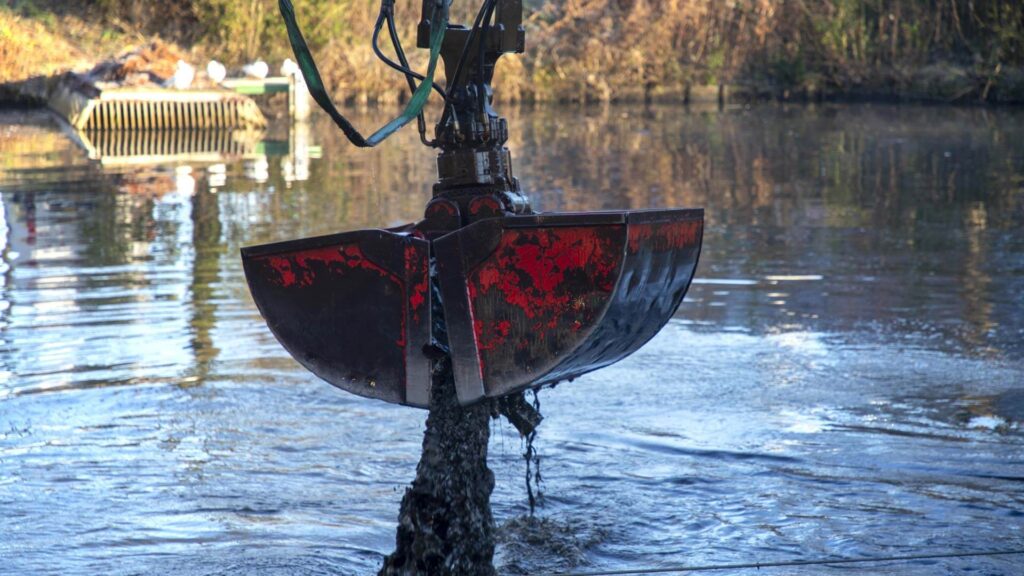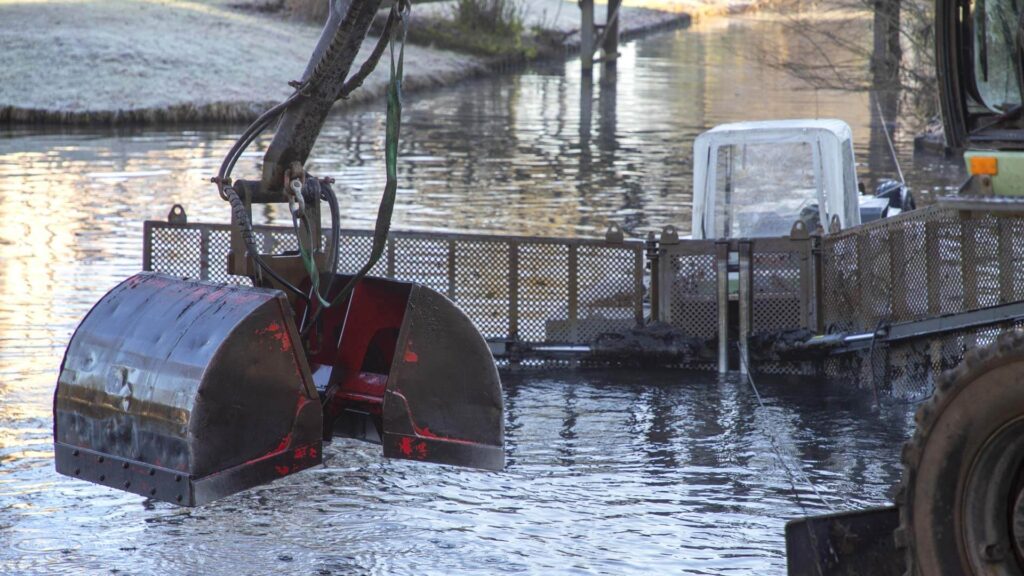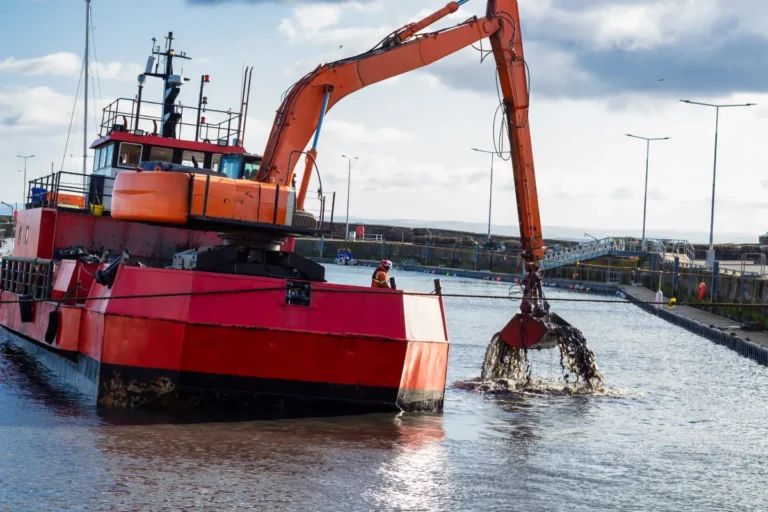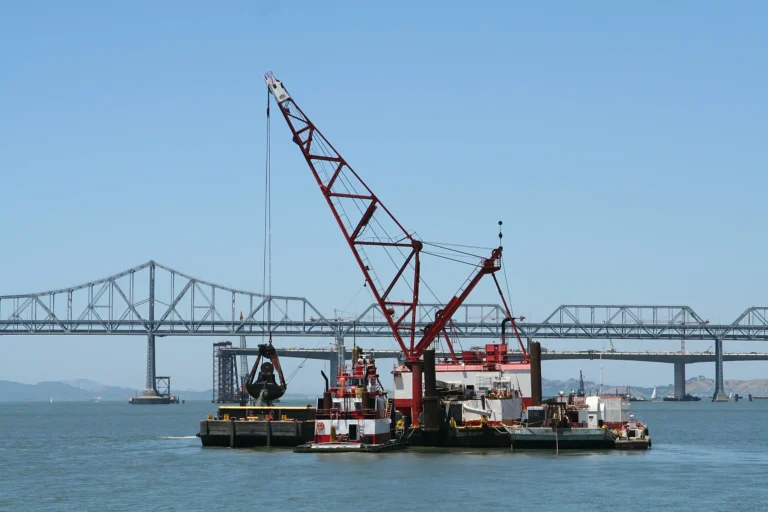Mechanical dredging is a widely used method for removing sediment and debris from water bodies to maintain navigable waterways, improve water flow, and support construction and environmental projects. It involves the use of heavy machinery, such as clamshell dredgers, excavators, and backhoes, to physically remove material from the bottom of rivers, lakes, harbors, and coastal areas. This method is particularly effective for handling coarse materials like sand, gravel, and rock, making it essential for projects that require precision and control. The ability to efficiently remove sediment and debris helps prevent flooding, maintain safe shipping channels, and protect marine ecosystems.
One of the key differences between hydraulic vs mechanical dredging lies in the method of sediment removal. While hydraulic dredging uses suction to remove sediment and transport it through pipelines, mechanical dredging relies on excavation and lifting using buckets, grabs, and other mechanical tools. This allows mechanical dredging to handle tougher materials and operate effectively in shallow or confined areas where hydraulic dredging may be less efficient. The advantages of mechanical dredging include greater precision, better handling of debris-laden material, and reduced turbidity, which minimizes environmental disturbance. This article will explore the key equipment used in mechanical dredging, its main applications, and the critical performance factors that impact its success.
What is Mechanical Dredging?

Definition and Process
Mechanical dredging is the process of removing sediment, debris, and other material from the bottom of bodies of water using heavy machinery such as excavators, clamshell dredgers, and backhoes. Unlike hydraulic dredging, which relies on suction and pumps to transport material through pipelines, mechanical dredging uses physical force to lift and remove material directly from the waterbed. This method is particularly effective for handling coarse or compacted materials such as sand, gravel, clay, and rock, as well as areas with high debris content.
The process of mechanical dredging involves four key stages: excavation, loading, transportation, and disposal. The dredger or excavator physically digs or scoops material from the waterbed, which is then loaded into barges or dump trucks for transport to a designated disposal site. Compared to hydraulic dredging, which is better suited for removing fine sediments like silt and mud, mechanical dredging offers greater precision and control. It is also more effective for site-specific excavation and removal of debris-laden material, giving it an advantage in projects that require targeted sediment removal and minimal environmental disruption. This makes the advantages of mechanical dredging particularly valuable for harbor maintenance, construction projects, and environmental cleanup efforts.
How Mechanical Dredging Works

The mechanical dredging process involves several distinct steps that ensure efficient and effective material removal:
- Excavation – The dredging equipment (such as a clamshell or backhoe) is positioned over the targeted site. The bucket or grab is lowered into the water to break up and collect the sediment. Mechanical dredging is highly effective in removing consolidated or compacted material, making it ideal for challenging excavation sites.
- Loading – Once the material is collected, it is transferred into a barge, hopper, or dump truck. Some dredging systems are designed to transfer material directly to the shore or nearby storage sites. The ability to handle large quantities of material in a single load improves operational efficiency.
- Transportation – After loading, the material is transported to a designated disposal site. Depending on the project requirements, this could be an onshore dumping area, a designated offshore site, or a processing facility for material recovery. Mechanical dredging allows for flexible transportation options, as the material is not bound to pipeline transport.
- Disposal – The sediment and debris are unloaded at the disposal site. In environmental dredging projects, the material may be treated or processed to remove contaminants before disposal. For beach nourishment or land reclamation projects, the dredged material may be reused to reinforce shorelines or create new land formations.
The use of specialized equipment, such as high-capacity dredgers and advanced excavation tools, enhances the efficiency and precision of the mechanical dredging process. Compared to hydraulic dredging, mechanical dredging provides greater control over the type and volume of material removed, allowing for more targeted and effective sediment management. These operational strengths underscore the key advantages of mechanical dredging for projects requiring precision and debris removal.
Key Equipment Used in Mechanical Dredging

The success and efficiency of a mechanical dredging operation depend largely on selecting the right equipment for the job. Different dredging conditions, sediment types, and project requirements call for specific types of dredgers. Each type of dredging equipment is designed to handle particular challenges, such as removing compacted material, operating in confined spaces, or ensuring precision in sediment removal. Below are the most commonly used dredgers in mechanical dredging and their respective applications, advantages, and limitations.
Clamshell Dredgers
Clamshell dredgers are one of the most commonly used types of equipment in mechanical dredging. They consist of a crane or derrick fitted with a clamshell bucket, which is lowered into the water to grab and lift sediment. The bucket is hinged, allowing it to open and close like a clamshell, which makes it effective for picking up both loose and compacted material.
- Best suited for:
- Harbor and port maintenance
- Environmental cleanup (removing contaminated sediment)
- Precision dredging in confined areas
- Advantages:
- High precision in sediment removal
- Effective in deep water and confined spaces
- Can handle a wide range of material types, including debris-laden sediment
- Limitations:
- Slower compared to continuous dredging methods
- Limited production capacity per cycle
- Less effective in removing very fine sediments
Backhoe Dredgers
Backhoe dredgers are large excavators mounted on a floating platform. The arm extends over the water, and a bucket scoops sediment from the waterbed. This type of dredger is particularly effective for removing hard and compacted materials.
- Best suited for:
- Nearshore dredging and construction
- Removing hard and compacted material
- Dredging projects that require precision
- Advantages:
- High excavation power for hard material
- Precise sediment removal
- Can operate in shallow water and confined spaces
- Limitations:
- Limited reach and depth compared to other dredgers
- Slower production rates compared to hydraulic dredging
- Less effective for fine or loose sediments
Bucket Ladder Dredgers
Bucket ladder dredgers consist of a series of buckets attached to a rotating ladder that continuously excavates sediment. The buckets scoop up material and transport it to a discharge point via a conveyor system. This type of dredger is ideal for large-scale, continuous dredging operations.
- Best suited for:
- Large-scale harbor and river maintenance
- Continuous dredging in deep water
- Removing sand, gravel, and other coarse materials
- Advantages:
- Continuous operation improves efficiency.
- High production capacity
- Effective for deep dredging and hard materials
- Limitations:
- High initial and operating costs
- Limited maneuverability in confined spaces
- Less effective for precision dredging
Dragline Dredgers
Dragline dredgers use a long boom with a bucket that is lowered into the water and dragged along the bottom to collect sediment. The bucket is then lifted and emptied onto a barge or nearby disposal site. Dragline dredgers are known for their ability to excavate at great depths.
- Best suited for:
- Deep excavation
- Removing large volumes of sediment
- Projects in open water and wide channels
- Advantages:
- High digging power for deep sediment removal
- Can handle large volumes of material
- Suitable for hard and compacted sediments
- Limitations:
- Limited precision in sediment removal
- Difficult to operate in confined or shallow areas
- High maintenance requirements due to complex machinery
Excavator Dredgers
Excavator dredgers are heavy-duty excavators mounted on floating platforms or barges. They use a hydraulic arm and bucket to scoop sediment from the bottom of the water body. Excavator dredgers are highly versatile and well-suited for projects that require precision and handling of debris-laden material.
- Best suited for:
- Precision dredging
- Debris removal and sediment handling
- Dredging in shallow water or nearshore areas
- Advantages:
- High precision and control
- Effective in shallow and confined spaces
- Can handle mixed material, including debris and vegetation
- Limitations:
- Lower production capacity compared to continuous dredgers
- Limited reach and depth
- Dependent on operator skill for maximum efficiency
Applications of Mechanical Dredging

Mechanical dredging is widely used across various industries for sediment removal, site preparation, and environmental management. Its ability to handle compacted materials, debris, and coarse sediment makes it an ideal solution for projects that require precision and control. Compared to hydraulic dredging, which is better suited for fine sediment and large-scale material transport, mechanical dredging offers advantages in targeted sediment removal and material handling. Below are the key applications where the advantages of mechanical dredging make a significant impact.
1. Harbor and Port Maintenance
Harbor and port maintenance is one of the most critical applications of mechanical dredging. Over time, sediment, silt, and debris accumulate in shipping channels and docking areas, reducing the available depth and making it difficult for vessels to navigate safely.
- Removing accumulated sediment – Clamshell and backhoe dredgers are commonly used to remove built-up sediment from port basins and entrance channels.
- Ensuring safe vessel passage and docking – Maintaining the correct depth allows larger ships to enter and dock without the risk of grounding.
- Debris removal – Mechanical dredging is particularly effective for removing debris, rocks, and hard materials that can damage ship hulls or impede port operations.
The precision and control of mechanical dredging make it ideal for confined spaces like ports and shipping lanes, where hydraulic dredging may not be as effective.
2. Coastal Protection and Beach Replenishment
Coastal erosion and storm damage can significantly reduce the shoreline and beach areas. Mechanical dredging restores these areas by transferring sediment and sand from offshore locations back to the beach.
- Restoring eroded shorelines – Mechanical dredgers can recover sand and sediment from offshore beds and deposit it strategically to rebuild beaches.
- Protecting against coastal erosion and storm damage – Replenishing sand helps absorb wave energy and prevent further erosion during storms.
- Precision placement of sediment – Mechanical dredging allows for more accurate placement of sediment compared to hydraulic dredging, ensuring the restored beach is stable and even.
Mechanical dredging has an advantage in beach replenishment projects because it can handle coarse material accurately and place it.
3. Environmental Dredging
Environmental dredging is essential for removing contaminated sediment from rivers, lakes, and industrial sites. Unlike hydraulic dredging, which can resuscitation fine particles and contaminants, mechanical dredging provides more controlled sediment removal.
- Removing contaminated sediment – Mechanical dredging is effective in lifting contaminated material without disturbing the surrounding water column.
- Ensuring environmental compliance – Many environmental regulations require precise removal of hazardous material, which mechanical dredging achieves more effectively than hydraulic dredging.
- Improving water quality – Removing pollutants, heavy metals, and industrial waste enhances the overall health of the water body.
The advantages of mechanical dredging in environmental applications lie in its ability to minimize turbidity and prevent the spread of contaminants.
4. Construction and Infrastructure Projects
Mechanical dredging is critical in marine and coastal construction projects that require site preparation and foundation work.
- Dredging for bridge foundations – Backhoe and dragline dredgers are commonly used to remove sediment and prepare the seabed for bridge piers and supports.
- Pipeline and cable installation – Mechanical dredging creates trenches for underwater pipelines and communication cables.
- Offshore structures – Oil platforms, wind farms, and other offshore installations require precise seabed preparation, which mechanical dredging handles effectively.
Mechanical dredging provides greater control and accuracy than hydraulic dredging, which is essential for construction projects requiring stable foundations.
5. Mining and Resource Recovery
Mechanical dredging is used extensively in mining operations to extract valuable resources such as sand, gravel, and minerals from underwater deposits.
- Extracting valuable materials – Clamshell and bucket ladder dredgers are used to recover heavy minerals, aggregates, and construction materials from riverbeds and coastal areas.
- Separating materials for processing and distribution – Mechanical dredgers can handle mixed materials, allowing for efficient separation and processing of valuable resources.
- Handling coarse and abrasive materials – Mechanical dredging is particularly effective for mining operations due to its ability to manage hard and compacted sediment.
The ability to target specific material layers and handle mixed sediment makes mechanical dredging the preferred method for resource recovery projects.
The advantages of mechanical dredging in these applications come from its precision, versatility, and ability to handle tough materials. Compared to hydraulic vs mechanical dredging, mechanical dredging excels in targeted sediment removal and site-specific excavation, making it the ideal solution for complex projects that require accuracy and control.
Advantages of Mechanical Dredging
Mechanical dredging offers several key advantages over hydraulic dredging, making it the preferred method for projects that require precision, control, and the ability to handle tough materials. Unlike hydraulic dredging, which relies on suction to remove sediment, mechanical dredging physically excavates and lifts material from the waterbed using specialized equipment such as clamshells, backhoes, and bucket dredgers. This gives mechanical dredging a higher degree of accuracy and operational flexibility, particularly in challenging environments. Below are the primary advantages of mechanical dredging that make it an effective solution for sediment removal and site preparation.
1. Precision and Control
One of the biggest advantages of mechanical dredging is its ability to target specific areas with minimal disruption to the surrounding environment. Mechanical dredgers provide greater control over the excavation process, allowing operators to remove sediment while selectively preserving adjacent structures and ecosystems.
- Accurate sediment removal – Equipment such as clamshell and backhoe dredgers allow for precise targeting of sediment layers, reducing the risk of over-excavation.
- Better handling of debris-laden material – Mechanical dredging is more effective at removing debris, including rocks, logs, and vegetation, which can clog hydraulic dredgers.
- Minimal disturbance to the water column – By lifting sediment directly from the bottom, mechanical dredging reduces the resuspension of fine particles, minimizing turbidity and protecting aquatic ecosystems.
Compared to hydraulic vs mechanical dredging, mechanical methods offer greater accuracy and control, especially in confined spaces or areas with mixed sediment types.
2. Versatility
Mechanical dredging is highly adaptable to different types of sediment and environmental conditions, making it suitable for a wide range of projects.
- Handles various sediment types – Mechanical dredging equipment can handle everything from soft clay and silt to hard-packed rock and gravel.
- Works in both shallow and deep water – Backhoe and clamshell dredgers are effective in confined, shallow areas, while dragline and bucket ladder dredgers are ideal for deep excavation.
- Effective in mixed material environments – Mechanical dredgers can handle environments with a combination of soft sediment and hard debris, which hydraulic dredgers may struggle with.
Mechanical dredging is a flexible solution for both inland and offshore projects because it can operate effectively under different site conditions.
3. Material Recovery
Mechanical dredging provides a higher potential for material recovery and separation, which is valuable in mining and resource extraction projects.
- Improved material separation – Mechanical dredgers allow for better sorting of valuable materials such as sand, gravel, and minerals from unwanted debris.
- Reusable material recovery – Dredged material, such as sand and gravel, can be processed and reused for construction, beach replenishment, and land reclamation.
- Reduced material loss – Unlike hydraulic dredging, which can lead to material loss through water mixing, mechanical dredging lifts material directly, reducing waste.
The ability to recover and repurpose dredged material adds significant value to mechanical dredging operations, making it a more sustainable and cost-effective solution.
4. Reduced Environmental Impact
Compared to hydraulic dredging, which can stir up fine particles and increase turbidity, mechanical dredging minimizes disturbance to aquatic ecosystems.
- Less turbidity – Mechanical dredgers lift sediment directly rather than agitating it, which prevents the spread of suspended particles and contaminants.
- Lower risk of contaminant spread – Mechanical dredging reduces the chance of resuspending hazardous materials, making it the preferred method for environmental cleanup projects.
- Preservation of aquatic ecosystems – By reducing sediment disturbance, mechanical dredging helps protect fish spawning areas, aquatic plants, and water quality.
The ability to minimize environmental disruption is a key factor in the growing preference for mechanical dredging in sensitive areas such as wildlife habitats and protected water bodies.
5. Operational Flexibility
Mechanical dredging is well-suited for challenging environments where hydraulic dredging may not be effective, such as shallow waters, confined spaces, and debris-laden sites.
- Effective in confined or difficult-to-access areas – Backhoe and excavator dredgers can operate effectively near shorelines, bridge pilings, and harbor walls.
- Less dependent on water flow – Mechanical dredging is not influenced by tidal patterns or water flow rates, allowing for more consistent operation.
- Adaptability to changing conditions – Operators can adjust the equipment and dredging method to match evolving project requirements and environmental conditions.
This adaptability gives mechanical dredging an edge over hydraulic methods, particularly for complex projects requiring site-specific excavation and sediment handling.
The advantages of mechanical dredging lie in its precision, versatility, material recovery potential, reduced environmental impact, and operational flexibility. For projects that involve hard or mixed sediment, confined working areas, or debris-laden environments, mechanical dredging provides superior results compared to hydraulic vs mechanical dredging methods.
Performance Factors in Mechanical Dredging
The success of a mechanical dredging project depends on a range of performance factors that influence efficiency and environmental impact. Mechanical dredging involves physically removing sediment using equipment such as clamshells, backhoes, and bucket dredgers. The type of sediment, site conditions, equipment selection, operator expertise, and regulatory compliance all play critical roles in determining the operation’s effectiveness. Understanding these factors helps maximize dredging performance while minimizing operational costs and environmental disturbance.
1. Type of Sediment
The type of material being dredged significantly affects the efficiency and equipment requirements for a mechanical dredging operation. Different sediments require different dredging techniques and equipment to ensure efficient removal without excessive wear and tear on the machinery.
- Sand and gravel – Best handled by bucket ladders and clamshell dredgers, which can efficiently lift heavy and coarse materials.
- Clay and silt – Backhoe and excavator dredgers are effective for cohesive materials like clay, which require high digging power to break up and lift.
- Rock and hard materials – Dragline dredgers and specialized cutting attachments are needed for hard or compacted sediment.
- Organic material – Material such as decaying plant matter or soft mud can be effectively handled using clamshell or excavator dredgers.
Matching the dredger type to the material being excavated is essential for improving efficiency and preventing mechanical damage. One of the key advantages of mechanical dredging is its ability to handle a wide range of sediment types, including mixed and hard materials, which hydraulic dredging may struggle with.
2. Site Conditions
Environmental factors and site-specific challenges can influence the efficiency and safety of a mechanical dredging project. Conditions such as water depth, flow rate, and site accessibility must be carefully evaluated during the planning phase.
- Water depth – Dragline and bucket ladder dredgers are effective for deep-water excavation, while backhoe and excavator dredgers are more suitable for shallow waters and nearshore operations.
- Flow rate and water movement – Mechanical dredging is less affected by currents and water movement compared to hydraulic dredging, which relies on suction.
- Underwater obstacles and debris—Logs, rocks, and artificial structures can obstruct dredging operations. Mechanical dredging excels at removing these materials without clogging or damaging the equipment.
- Environmental sensitivity—Mechanical dredging’s ability to minimize turbidity and sediment disturbance is a major advantage in areas with delicate ecosystems or protected habitats.
Compared to hydraulic and mechanical dredging, mechanical methods perform better in shallow or debris-laden sites, where precise excavation and material handling are essential.
3. Equipment Selection
Selecting the right equipment for the project is crucial for optimizing performance and minimizing operational costs. Different dredging environments and sediment types require specific dredger types to achieve maximum efficiency.
- Clamshell dredgers – Best for deep, targeted dredging in ports and harbors.
- Backhoe dredgers – Ideal for nearshore operations and hard, compacted materials.
- Bucket ladder dredgers – Suited for continuous dredging in large-scale projects.
- Dragline dredgers – Effective for deep excavation and large-scale sediment removal.
- Excavator dredgers – Best for precision dredging and mixed material handling.
Using modern, well-maintained equipment improves dredging efficiency and reduces downtime caused by mechanical failures. One major advantage of mechanical dredging over hydraulic methods is the ability to match the dredger to the sediment type and site conditions.
4. Operator Skill and Experience
The operator’s expertise directly impacts the accuracy, efficiency, and safety of a mechanical dredging operation. Skilled operators can adjust to changing site conditions and sediment types, improving the project’s overall success.
- Precision and accuracy—Experienced operators can more effectively target sediment layers, reducing the need for rework and minimizing material loss.
- Adaptability to site conditions – Skilled operators can adjust the dredger’s positioning and excavation angle to handle varying sediment types and underwater obstacles.
- Training and certification—Training operators on dredger operation, site assessment, and sediment handling improves overall performance and reduces equipment damage.
- Safety awareness—Proper handling of heavy machinery and understanding of site-specific risks ensure safer working conditions and minimize operational delays.
Operator expertise is particularly important in complex projects where precision and adaptability are required. This gives mechanical dredging an advantage over hydraulic methods, which are more automated but less adaptable to changing site conditions.
5. Environmental and Regulatory Compliance
Environmental impact and regulatory guidelines play a significant role in planning and executing a mechanical dredging project. Compliance with environmental regulations helps prevent legal issues and ensures sustainable dredging practices.
- Permits and approvals – Projects often require permits for sediment removal, transport, and disposal, especially in sensitive environmental areas.
- Noise and emissions control – Mechanical dredgers generate noise and engine emissions that may be regulated, especially in urban or residential areas.
- Turbidity and sediment disturbance – Mechanical dredging’s ability to minimize turbidity and prevent the spread of contaminants gives it a regulatory advantage in sensitive environments.
- Sediment relocation and disposal – Sediment removed during dredging must be transported and disposed of according to environmental guidelines, including potential testing for contaminants.
Compared to hydraulic vs mechanical dredging, mechanical dredging is often preferred in environmentally sensitive areas because it produces less turbidity and reduces the risk of contaminant spread. Maintaining compliance with environmental regulations ensures that the project proceeds smoothly without interruptions or fines.
Hydraulic vs. Mechanical Dredging
Understanding the differences between hydraulic and mechanical dredging is essential for selecting the right method for a dredging project. While both methods remove sediment and debris from the bottom of water bodies, they use fundamentally different techniques. The choice between hydraulic and mechanical dredging depends on the type of material being dredged, the site conditions, and the desired level of precision.
1. Key Differences
The primary difference between hydraulic vs mechanical dredging lies in the method of excavation and material handling.
- Excavation Method:
- Hydraulic dredging – Uses suction to remove sediment and transport it through pipelines. The material is mixed with water to create a slurry, which is then pumped to a disposal site.
- Mechanical dredging involves using physical force to excavate sediment with a bucket or grab. The material is then lifted and loaded onto barges or trucks for transport and disposal.
- Material Handling Capacity and Efficiency:
- Hydraulic dredging – Best for fine materials such as silt, mud, and sand. Large-scale removal is possible, but handling debris and coarse materials can reduce efficiency.
- Mechanical dredging – Better suited for coarse or compacted materials such as gravel, clay, and rock. Mechanical dredging provides greater control over the size and volume of material removed.
- Site Conditions:
- Hydraulic dredging – Works best in open areas with consistent water flow and minimal debris.
- Mechanical dredging – More effective in confined spaces, nearshore areas, and debris-laden environments.
Hydraulic dredging is preferred for large-scale projects where sediment removal over a wide area is needed, while mechanical dredging excels in precision, debris removal, and hard material excavation.
2. Advantages of Mechanical Dredging Over Hydraulic Dredging
Mechanical dredging offers several advantages that make it the preferred method for certain types of dredging projects:
- Better Handling of Hard and Compacted Materials
- Hydraulic dredging struggles with heavy, coarse materials like gravel and rock due to limitations in suction capacity.
- Mechanical dredging uses buckets, grabs, and cutting attachments to break down and lift hard materials more effectively.
- Clamshell, backhoe, and dragline dredgers are designed to handle high-resistance material without clogging or reduced performance.
- Greater Precision and Control
- Mechanical dredging allows operators to accurately target specific sediment layers, ensuring that only the intended material is removed.
- Backhoe and clamshell dredgers provide excellent control in confined areas, such as harbors, docks, and nearshore sites.
- This precision minimizes the risk of over-excavation and reduces the need for rework.
- Lower Environmental Disturbance
- Hydraulic dredging creates turbidity by mixing sediment with water, which can spread contaminants and harm aquatic life.
- Mechanical dredging removes material directly, reducing the resuspension of fine particles and contaminants.
- The reduced environmental impact makes mechanical dredging more suitable for sensitive ecosystems and protected habitats.
The advantages of mechanical dredging are particularly valuable in projects requiring precision, low turbidity, and the ability to handle coarse or debris-laden material.
3. When to Choose Mechanical Dredging Over Hydraulic Dredging
Mechanical dredging is not always the best solution, but certain project conditions make it the more effective option:
- Sites with High Debris or Rocky Material
- Hydraulic dredging is less effective when dealing with debris, such as logs, rocks, and industrial waste.
- Mechanical dredgers like backhoes and draglines can lift and remove large debris without damaging the equipment or reducing performance.
- In mining or resource recovery, mechanical dredging is preferred for handling mixed materials.
- Projects Requiring Targeted Sediment Removal or Structural Excavation
- Mechanical dredging allows for precise sediment removal, making it ideal for site preparation and foundation work.
- Backhoe and clamshell dredgers are commonly used for bridge construction, pipeline installation, and offshore infrastructure projects.
- The ability to control the depth and excavation angle is crucial in these types of projects.
- Environmental Sensitivity and Limited Water Flow
- Hydraulic dredging requires consistent water flow to transport sediment through pipelines.
- In low-flow areas or shallow water, mechanical dredging provides greater efficiency.
- Mechanical dredging reduces sediment disturbance and prevents contaminant spread, making it more environmentally friendly in protected areas.
When precision, material recovery, and environmental sensitivity are critical, mechanical dredging is often the preferred method. Its ability to handle complex materials and operate in challenging environments gives it an advantage over hydraulic methods in many applications.
Conclusion
Mechanical dredging plays a vital role in maintaining waterways, supporting construction projects, and managing sediment removal in environmentally sensitive areas. Its ability to handle hard, compacted materials and debris with precision makes it a more effective solution in situations where hydraulic dredging may struggle. The key advantages of mechanical dredging—greater control, better material recovery, and reduced environmental impact—make it the preferred method for projects requiring targeted excavation and minimal disturbance to aquatic ecosystems. By selecting the right equipment and understanding the specific site conditions, mechanical dredging can be optimized to improve project efficiency and reduce operational costs.
Choosing between hydraulic vs mechanical dredging depends on the project’s requirements, sediment type, and environmental considerations. While hydraulic dredging excels in large-scale sediment removal of fine materials, mechanical dredging offers greater flexibility and precision in challenging conditions. For projects involving coarse materials, debris, or confined spaces, mechanical dredging provides a distinct advantage. With the right equipment, skilled operators, and proper site assessment, mechanical dredging ensures reliable performance and long-term project success.





